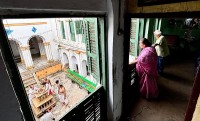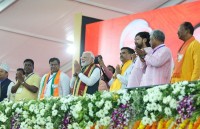image
US investigating team believes Indian field evidence may provide answer to WWII unaccounted-for-personnel
Kolkata, Jun 1 (IBNS): The US Consulate General Kolkata recently hosted a talk titled The Anatomy of a Dig: Forensic Science and Anthropology, Two Sides of the Same Coin.
It was followed by an interactive session by Lt. Col. Kevin M Pritz and Dr Meghan-Tomasita Cosgriff-Hernandez of the US Department of Defense Prisoner of War/Missing in Action Accounting Agency (DPAA).
They discussed how the various facets of forensic science and anthropology play a vital role in assisting the DPAA in recovering the remains of missing US soldiers.
DPAA is said to manage the largest forensic anthropology lab in the world, where researches sift through the remains of missing service members from World War II, Korea and Vietnam, then try to match them to DNA and return them to their loved ones.
The Government of India and DPAA have a history of cooperation in this significant undertaking.
With full support from Government of India, the DPAA conducted field activities in Arunachal Pradesh, India from November 1 – December 14, 2016, in search of US World War II unaccounted for personnel.
The DPAA team recovered evidence that was subsequently examined by a Joint Forensic Review Committee comprising both DPAA and Anthropological Survey of India (AnSI) members.
On December 7, 2016, the committee determined that the evidence was possibly correlated to the US WWII service members unaccounted for from that region, and recommended the remains and material evidence be transported to a DPAA laboratory for further analysis.
In June 2017, DPAA personnel will escort the evidence from Kolkata to the US laboratory in Honolulu, Hawaii, for analysis.
This activity marked the seventh mission relating to US unaccounted for personnel conducted in India.
Past missions include three recovery missions during 2008 and 2009 in Arunachal Pradesh, one investigation in Tripura in 2013, one investigation in Assam and Nagaland in 2014, one recovery in Arunachal Pradesh in 2015, and one investigation in Arunachal Pradesh 2016.
Top Headlines
-
News
CSR in the Crossfire: Professor and practitioners debate over ethics in India Inc. at Kolkata's MCHD talk
October 24, 2025
-
News
Jashanpreet Singh Case: California under fire for licensing undocumented truck driver
October 24, 2025
-
News
India upgrades Technical Mission in Kabul to Embassy, days after Muttaqi's visit to New Delhi
October 22, 2025
-
News
Pakistan, Afghanistan agree to 48-hour ceasefire after deadly border clashes
October 15, 2025
-
News
Afghan Taliban, Pakistan exchange gunfire, dozens killed
October 15, 2025
-
News
Trump hails Netanyahu in Israel after hostage release, declares historic dawn of a new Middle East
October 13, 2025
-
News
Historic dawn of a new Middle East: Donald Trump addresses Israeli Parliament
October 13, 2025
-
News
Shah Rukh Khan receives maiden National Award from President Droupadi Murmu
September 23, 2025
-
News
Kolkata: Ahiritola Yubak Brinda invites Auram to make jewellery for Ma Durga and her family
September 20, 2025
-
News
Israel-US alliance 'never been stronger', Netanyahu says as State Secretary Rubio visit for talks
September 15, 2025





